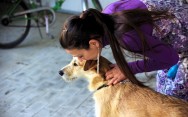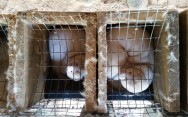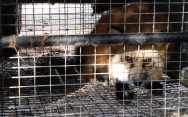Blog Archives
Home -
Archive by category "Uncategorized"
A solar eclipse is a temporary, but dramatic event that humans historically have striven to
understand, whether they arrived at mystical, religious or scientific conclusions. Humans, however,
are not the only animals to react to an eclipse of the sun. So far there have not been extensive
studies of what animals do when confronted by a solar eclipse, but scientific research emerging out
of the April 8 th eclipse might reveal how animals react to a total eclipse of the sun.
The results so far suggest that animals react in a number of different ways. The current
understanding also reveals how animals are sensitive in ways that humans may not be. Animals are
like humans in many ways, and one of these ways is that all animals are different, and have different
capabilities, heightened senses and social understandings of their environment.
For example, Jane Goodall observed chimpanzees pointing at a solar eclipse and screaming. Baboons
were observed increasing their grooming behavior, which is often associated with a stress response.
Other research observed animals launching into nighttime behaviors as if it was time to sleep.
Overall, animal behavior was diverse across different species, as some birds began singing new
songs, some spiders began weaving a different kind of web or breaking their webs, and many other
behaviors were observed that may have meaning only to the animals. Many animals displayed
anxiety and some animals, such as bears, were indifferent. Galapagos turtles began attempting to
breed during the eclipse.
Animal sensitivity could cause certain reactions in animals, to changes caused by the eclipse.
Photosynthesis drops during an eclipse, and charged particles in the atmosphere can cause heat
fluctuations and solar winds. Animals sensitive to oxygen, C02, temperature and wind could be more
acutely aware of an eclipse.
One thing that animal reactions teach us is that animals are not a block – they are many different
species of beings that share the earth with us and react differently to various stimuli.
A number of projects have begun researching animals’ response to the recent solar eclipse, and
they have invited the public to share their research findings from the eclipse. All animal research
should be conducted humanely and without harm or stress caused to the animals. Please support
research projects and gather research that does not harm animals. https://youtu.be/-fkgb4yBUuk?si=gYjpncxlNX-w3lmm
Using hidden cameras in agricultural facilities is still one of the best ways to reveal the horrific cruelty of industrial agriculture. This is why states continue to pass “ag gag” laws to restrict and punish any exposure of practices at agricultural facilities.
An animal rights group, Mercy for Animals, used hidden surveillance to protest Senate Bill 16 in Kentucky, which aims to criminalize the use of recording equipment such as drones, cameras, video recorders, audio recorders etc. inside concentrated animal feeding operations. In doing so they exposed exactly the reason why criminalizing these practices shields violence and cruelty from the public eye.
Workers are known to abuse animals horribly at industrial agriculture facilities, and the farms that Mercy for Animals exposed were no exception. The group released videos showing workers kicking, stepping, throwing and stuffing chickens into cages for transport. The farms are described as contract farms providing chicken to Pilgrim’s Pride, one of the largest chicken producers in the United States.
Large industrial farms continue to claim that animals are killed humanely, and any problems are the result of bad apples. But the scale of cruelty and killing at these farms reveals that it is the norm for workers to dehumanize animals and abuse them before killing them. This is part of a psychological process that is not separate from industrial farming, it’s normalized by workers exposed to violence every day as part of their job. Animal rights groups continue to expose these conditions, and the farming groups protest that the problem is the individuals involved, and not the industrial scale of the killing operation itself.
One of the key tools animal rights activists have at their disposal is drones, which are cheap and capable of recording poor conditions, animal abuse and illegal hunting. Footage captured by drones has led to many successful campaigns on behalf of animals.
If blocking surveillance of animal rights abuses were just protecting private property, why is it that industrial farming interests are always behind these laws? The cruelty that we see on footage obtained by animal rights groups is clearly a fraction of what actually exists. We must continue to fight for the right to expose horrific cruelty and the lies of the industrial farming industry.
The Miami-Dade commission has served eviction papers to the Dolphin Company, the owners of the Miami Seaquarium, after the company presided over severe neglect and poor conditions for animals in their care for many years. The Miami-Dade commission has ordered the Dolphin Company to vacate the premises by the 21st of April 2024. The commission’s letter cited violations of the lease agreement which included “not just a default, but a complete disregard for the safety of the animals housed on the premises.”
The history of the park is one of sadness, neglect, cruelty and enslavement for animals. The park’s history as an amenity for humans on the other hand, is one in which it enriched a private company and in the park’s earlier years was the third largest contributor to Miami-Dade County’s revenue through lease and tax payments.
The park is behind at least $180,000 in rent, which is one reason for the Miami-Dade commission’s decision. The decision was also motivated by the park’s numerous USDA violations and the loss of its Humane Society of America certification. Animal rights organizations have spoken out against the facility for years, in some cases managing to rescue animals, such as a pair of manatees, Romeo and Juliet. At least 120 dolphins and whales have died in captivity at the park. A dolphin named Sundance recently died shortly after a USDA inspection, where it was noted that the dolphin had “signs of gastric distress.” Federal inspections showed that the park’s infrastructure was deteriorating. A dolphin was found with a two-inch nail in its throat. Another dolphin was found with a broken metal bolt in its mouth.
One of the park’s major problems was that it couldn’t keep staff. Multiple staff resigned at the conditions of the park, and some alleged retaliation when they tried to speak up against the conditions. Due to money problems and difficulty retaining staff, the park didn’t have enough veterinarians to attend to the animals. The veterinary lab lacked basic tools and the animals were denied surgery, including a sea lion with eye pain, who stopped eating. One of the park’s animals, an Orca named Tokitae, gained recognition for all the wrong reasons, because the tank she was forced to live in was the nation’s smallest tank. Since coming to the world’s attention, Toki, also known as Lolita, has died.
Why did it take so long for the neglect to be put to an end? There is a bureaucratic process that has to happen to hold such facilities accountable. The park was known to be an unhealthy and cruel place for animals to live for decades. Attention wasn’t focused on the park soon enough because parks like these were for many years deemed to be acceptable entertainment and education for humans. The roles of animals at these parks, who are forced to perform for humans, and who are kept in restrictive conditions and separate from family members, were not questioned. It’s now time to question the rationale for keeping animals in these facilities. There may be some conservation reasons for keeping some species of animals captive, but even then, keeping animals in captivity, where they can be exploited, should be viewed with public skepticism and treated as a last resort.
|
Tags: Animal Neglect,
animal rights,
Animals in Captivity,
Dolphin,
Kevin Boileau,
Marine Animals,
Marine Park,
Miami Seaquarium,
Nazarita Goldhammer,
Orca,
Toki the Orca,
Whale
The death of New York’s beloved owl Flaco was a tragic event that drew attention to the way in which a city-dwelling bird’s life can be tragically cut short. The cause of death? It seems that Flaco died after a collision with a building. Flaco’s death was also attributed to 4 kinds of rat poison that were found in his system. Additionally, he was also found to have a severe case of “pigeon herpesvirus” from eating feral pigeons. Toxicology also showed a breakdown of the pesticide DDT, but the levels of the pesticide were not significant enough to cause his death. The rodenticide and virus were both capable of causing severe illness, according to Dr. Paul Calle, chief veterinarian for the Wildlife Conservation society, though it’s unclear which one was responsible for the bird’s death. Flaco’s ultimate cause of death, a collision with a building, would likely have been caused by the bird flying disoriented while he was suffering from illness and poisoning.
Bird collisions are an incredibly common cause of death for birds. They are the second most common cause of death after domestic cats. Collisions with building glass kill between 90,000 and 230,000 migrating birds in New York City each year, according to Audubon NYC’s research. In addition, birds that dwell in big cities have much more contend with, as they have to deal with toxic pesticides commonly used by private homeowners in big cities like New York City. Wild Bird Fund director Rita McMahon said that rodenticide is to blame for 84% of the deaths of birds that they encounter, and that the poisons can stay in a bird’s system for up to 100 days.
Flaco was a Eurasian eagle-owl that escaped the Central Park Zoo after someone cut his cage’s stainless steel mesh. The Zoo attempted to recapture Flaco, but he began to improve his hunting skills and gain independence, so the Zoo were not able to entice him back with food.
Sightings of Flaco began to be common. New Yorkers celebrated the bird’s presence and his successful bid to live in the wild. The Central Park Zoo cautioned that Flaco might be endangered by eating a poisoned rodent or might prey on sensitive species. Flaco seemed to be doing well, but then in February 2024, a fallen owl was reported to the Wild Bird Fund, and the owl was confirmed to be Flaco. New Yorkers mourned his death and created a memorial to Flaco at the base of his favorite tree in Central Park.
Flaco’s death was a tragedy, but his life was an inspiration. Though he was safe at the Zoo, he followed his natural instinct for freedom and lived a life of independence before he died. His death has focused attention on the issue of bird safety in cities, and what humans can do to make cities safer for birds. New York Senators have renewed a push to pass the Dark Skies Act and renamed the Bird Friendly Buildings Act the FLACO Act. These pieces of legislation will require state owned buildings to make bird friendly provisions in their architecture and to reduce lighting at night, which has been shown to disorient night migrating birds that may fly into cities and die by collision. Birds face a host of threats in cities, including bird collisions, habitat loss, and poisoning by pesticide or rodenticide.
Flaco the owl was an animal who stood out and reminded city dwellers that animal lives have meaning. With the publicity around his death, now is a good time to push local legislators to take steps to introduce legislation to make cities more bird friendly. You can also reach out to your local bird conservation societies to see how you can join the effort to protect birds in cities.
Stray cats often cause controversy in communities because they can threaten bird populations and other vulnerable populations of local animals. Within communities, there are groups who think that violently culling cats is the answer. However research and conscience dictates that this practice is both unnecessary and cruel. There are many humane solutions that involve management and relocation of the wild cat population. Despite this, some communities still choose to kill wild cats.
The Dutch province of Friesland is a particularly cruel example of communities turning on wild cats with violent solutions. Shooting stray cats is generally allowed under Dutch law, but every other province has moved to ban the practice. Friesland is the only province that still allows the shooting of stray cats as a population control method.
The Animal Rights Organization Dier&Recht has called on the province of Friesland to immediately end the cruel practice of shooting and killing stray cats. The organization says that the province is relying on outdated regulations and that the decline in the bird population has little to do with stray cats. By shooting stray cats, they point out, there’s a risk someone’s beloved pet could be murdered. Not to mention the fact that shooting an animal fatally is an extremely cruel and painful way to end any animal’s life.
Other Dutch provinces use humane methods like trap, neuter and release. The cats are neutered, chipped and relocated to farms, riding schools and markets. According to the animal rights activists this practice is effective because it helps with noise complaints, as neutered cats don’t go on heat.
When combined with efforts to involve and educate the community, TNR can also be extremely effective in promoting responsible cat ownership, so pet cats are adopted from shelters and neutered, which in time will reduce the cat population.
It is generally recognized that killing large numbers of cats in an effort to reduce the population is a dangerous, cruel and ineffective way of managing a wild cat population. The Dutch province of Friesland killed 250 cats in 2021 alone. This cruel and unconscionable practice must not be allowed to continue. To learn more about Dier&Recht’s campaign to put pressure on Friesland to stop this practice, please visit their website: https://www.dierenrecht.nl/
https://nltimes.nl/2023/01/10/animal-rights-org-calls-friesland-stop-shooting-stray-cats
|
Tags: Animal Cruelty,
animal rights,
Community Cats,
Culling Wild Animals,
Feral Cats,
Kevin Boileau,
Nazarita Goldhammer,
Neuter and Release,
Stray Cats,
Trap,
Wild Cats
Human ability to use language is the reason behind many spurious claims of human supremacy over animals. As science advances however, it’s become clear that animals, particularly social species like dolphins and apes, do use signals to communicate, from sign language to underwater acoustic signals.
The pattern recognition ability of AI is now being used to analyze large data-sets of animal communication behaviors. The aim is to find patterns in communication signals that correspond to animal responses. Soon, we may be able to communicate with animals and actually ask them what their perspective is rather than imposing our human-centered perspective on them.
The use of AI to divine the secret world of animal communication has a trans-humanist bent. It goes beyond our limited ideas about our place in the world and the cosmos, as uniquely gifted life-forms who have the right to do what we want to other species.
AI research doesn’t only cover individual animal communications (bioacoustics), but also ecosystem communication (ecoacoustics). Already this research is being employed in such projects as recording the development and health of a reforested area of rainforest. It is also being used to monitor marine communications from cetaceans (whales and dolphins) with highly developed acoustic languages as a way of identifying groups of animals that could be at risk of colliding with ships and to establish marine protection zones.
Since animals are autonomous, sentient beings with their own agenda, it’s not clear if they will welcome communication initiated by humans. Whenever paradigm-changing technology arrives, it should always be wielded with extreme care to manage its impact on all forms of life and ecosystems. In the best case scenario, when humans decentralize our place in the natural world with a new understanding of animal communication, we could start to see human choices as a process of consultation with the animal and natural world rather than a cruel process of dominion over it.
https://www.weforum.org/agenda/2023/01/how-artificial-intelligence-is-getting-us-closer-to-talking-to-animals/
The news about climate change keeps getting worse. According to recent UN reports, we only have ten years to prevent its worst effects. But until then, at least we have time to save ourselves – and that is the narrative that matters to the media. Sadly it’s already too late for many animals. As well as deadlines focused on human survival, we should try to think about our actions in terms of animal survival. This article, for example, focuses on the dangerous difference between 1.5 degrees and 2 degrees of warming, and a small mention of the effect this would have on animal life, but mostly in terms of how it impacts humans.
This month there is something you can do for animals at the poles who are suffering from the effects of climate change. Leaders are meeting in Australia to discuss the proposal to create a sanctuary for animals at the Antarctic. Last year, only 2 penguin chicks in a colony of 40,000 penguins survived. The rest starved to death. Species are under pressure because of climate change, but at least creating a sanctuary could protect their food supplies by shielding them from overfishing.
Please sign and share the news before leaders meet on the 22nd.
It seems that the sexual fallout of the Pamplona festival is finally encouraging some joined-up thinking on the connection between violence towards animals and humans. The Pamplona bull festival, and bull running/bull fighting in general, hides under an umbrella of local color, riotous celebration and the endorsement of many, including the writer Hemingway, who considered it a healthy expression of masculinity. The festival “tests” young men during the running of the bulls through the town, before the actual bull-fighting, a stampede which claims human lives. But all this is just a prelude to what happens to the bull in the ring, which is described here:
“Over the course of the corrida, the bull is first enraged by the actions of the toreros, then stabbed with a lance, then planted with barbed spears (bandilleras), then further enraged by the matador, then – if all goes according to plan – killed by the matador, who plunges a sword directly into its heart. That’s an agonising enough death, but if something goes wrong it can be even worse for the bull: if the matador misses the bull’s heart during the final stage of the fight, the bull’s lungs will be punctured and it can either slowly drown in its own blood, or endure several attempts to land the killing blow. Only in exceptionally rare circumstances does the bull receive an indulto or pardon, which spares it from being killed.”
Because these traditional “corridas” are protected by Spanish law, it’s been easy to let the festivals idle away in an archaic space where the death of the animal is purely symbolic rather than real, where people can brush the bull’s suffering under the carpet. It’s the fallout in sexual harassment and sexual assault that is waking people up to the idea that violence doesn’t stop at the boundary of the bull ring. Violence is a chain reaction that causes people to diminish the value of other living beings in disturbing ways. Earlier this year, a woman’s rape at the festival was reduced to a “sexual abuse” sentence for her perpetrators. Since then, the festival has made strenuous attempts to be friendlier and more responsive, but women in particular still feel threatened at the festival. Hemingway called the festival a safe way of witnessing a war (completely denying the complicit participation in the death of the bull). At the heart of this festival is an unchallenged myth of toxic masculinity (the story of the half-human, half-bull Minotaur is a story of rape). Supporters of the festival still maintain that the festival is a vital test for “masculinity” – yet they have no good ideas for how violence is contained once it’s unleashed.
Read More: http://time.com/5331622/spain-pamplona-san-fermin-bull-festival/
http://junkee.com/junk-explained-what-is-bullfighting-and-why-is-it-still-around/51253
It may not be good news yet, but it seems as though the Yulin dog festival’s days are numbered. There
was tentative hope of a ban by the Yulin officials in May. This would have delivered a significant blow to the dog meat industry in China by sending out a strong cultural signal. It didn’t happen though, and the festival is still taking place.
The Yulin Dog Festival is an open slaughter of dogs and cats. Despite the defense of the ancient practice of dog-meat eating, the festival itself isn’t an ancient fixture of Chinese culture – it was officially launched in 2010. It invites the public – including children – to witness the horrifying slaughter of cats and dogs who are caged in the streets (though this is now officially prohibited). Some of these animals are stolen pets.
One positive development is the growing lack of sympathy of the general public towards the event. This
can be attributed to the work of activists, but also to the public horror of the festival itself. These days, only 20 percent of the Chinese population eats dog meat, and the festival’s dead have been reduced from 10,000 to 3,000 – still too many. Young people appear to be much less supportive of the festival and more inclined to be involved in animal activism. Strong resistance has helped bring about these changes, but much more pressure is required to rescue thousands of cats and dogs from their fate.
Now’s the time to raise awareness, sign the petition and donate to rescue groups who are apprehending
animals trucked to the festival!
Further Reading:
https://www.express.co.uk/news/nature/968244/yulin-dog-meat-festival-Peter-Li-days-numbered
https://www.independent.co.uk/voices/yulin-dog-meat-festival-china-animal-rights-chinese-culture-western-interference-a7800416.html
It is our moral duty to urge South Koreans to stop their practice of torturing and murdering dogs and puppies. Just because that is the practice of their culture does not make it right; and just because we American are thousands of miles away doesn’t mean we don’t have a moral duty to stop this heinous behavior.
See a few YouTube videos and then reflect on your duties.








Social Media